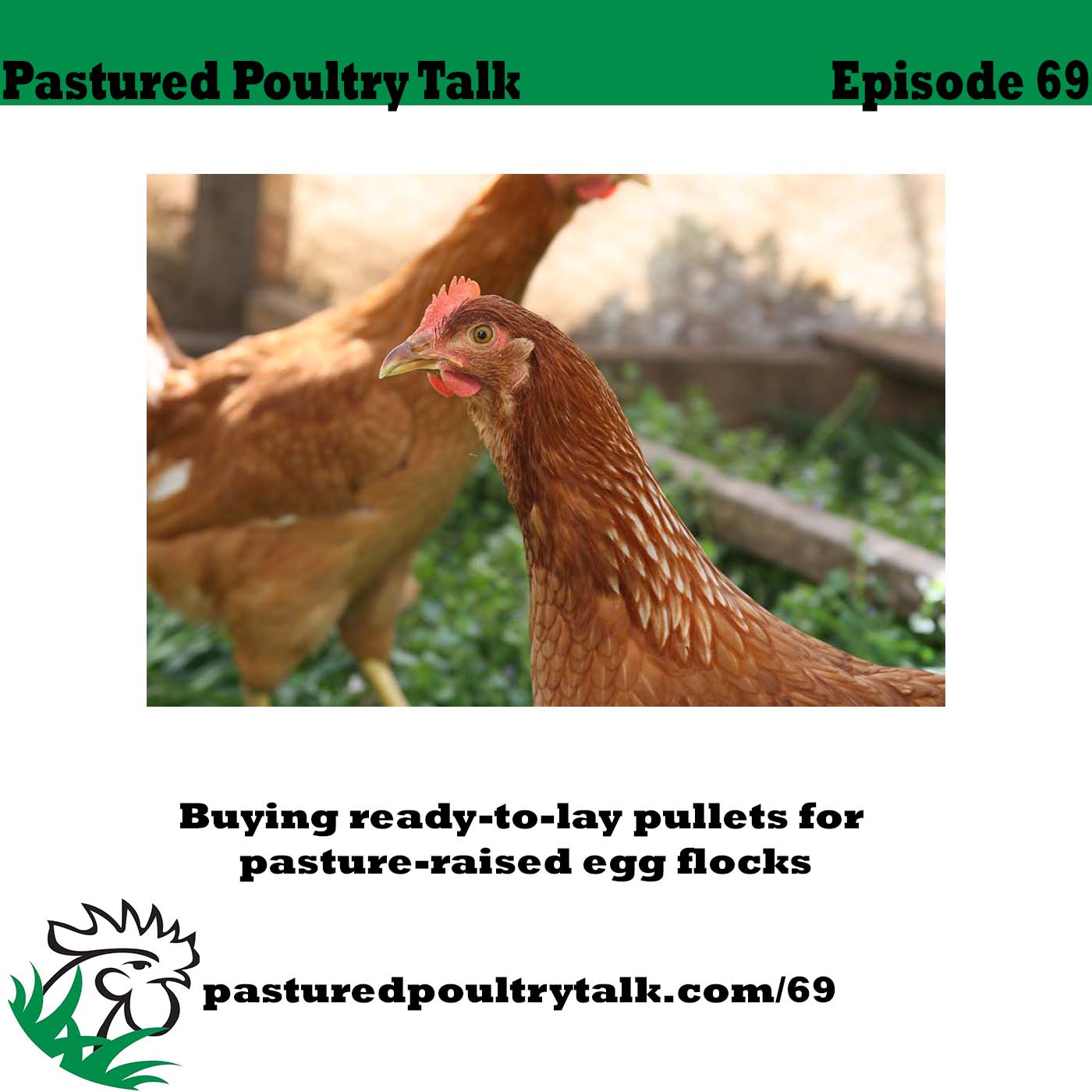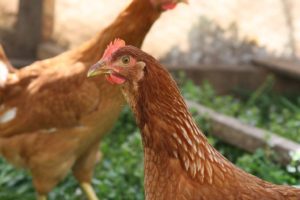
[podcast src=”https://html5-player.libsyn.com/embed/episode/id/6524867/height/90/theme/custom/thumbnail/yes/direction/forward/render-playlist/no/custom-color/88AA3C/” height=”90″ width=”100%” placement=”top” theme=”custom”]Ready-to-lay pullets, sometimes called point-of-lay, are one of the pastured egg farmers best competitive advantages. But it’s not all upside. Pullet supplier Mike Badger discusses the advantages, disadvantages, and opportunities for farmers to save money on replacement pullet costs. It also calls out an unmet demand in the pastured layer community for a diversity and quantity of birds.

Look at the beautiful beak on that ready-to-lay pullet.
(Dis)Advantages of Ready-to-Lay Pullets
Generally speaking, the advantages to buying point-of-lay pullets are:
- Competitive cost over raising your own by leveraging commercial scale.
- Ready-to-lay pullets were raised with proper nutrition.
- Avoid risk of disease, distraction, and predation.
There are also some disadvantages:
- Production system – Commonly available pullets are are not pastured and may be beak trimmed. Mike sells untrimmed beak ready-to-lay pullets through Badger’s Millside Farm.
- Breed availability – It’s typically hard and expensive to find non-commercial hybrids (i.e., the sexlinks) as ready-to-lay pullets.
- Feed during the grow-out – Many pastured producers feed non-gmo (not organic) or a certified organic feed, but large suppliers do not.
This episodes talks through all these issues, and puts them in context.
Economics and Cost Benefits of Ready-to-Lay Pullets
A common question that many pullet dealers get is, “how can you sell started pullets for that price?” The answer is self evident, but still not believable. The only thing you need to understand is that you, as a direct-marketing farmer, need to raise a lot of birds to compete with the large suppliers and their dealer networks.
This episode features some napkin math to prove the cost benefit of pullets against raising your own layers from day 1. We don’t need to go very far to realize the deal.
The napkin math for raising your own pullets from day old is simple: cost of chick + cost of feed + labor per bird. The episode dives into these numbers and assigns values to raising your own 17 week old laying hens in flocks of 250 and 600. For comparison, we look at a non-gmo feed and a certified organic feed.
Chicken math on a napkin or the back of the envelope is beautiful.
Calculating the Cost of a Replacement Pullet
Based on an APPPA survey I conducted several years, the average pasture-raised egg laying flock was 225, so I’ll round that up to 250. At the APPPA conference in Arkansas, the median sized egg flock of that group of experienced producers was somewhere around 600 birds. Let’s compare those two flock sizes.
I can source a day old production hybrid layer from Moyer’s for $2.50 each. If I give the birds 30 minutes of labor each day for 17 weeks, I’ve got 60 hours of labor (it’s actually 59.5 hours, but you’ll find a way to spend that half hour).
We estimate total feed consumption to be 20 pounds per hen during that time. Can it be better? Yes.
I can source organic feed for approximately .40/ lb and non-gmo for .30/lb.
Let’s put it all together.
Cost of chick + Labor per pullet + feed cost.
Labor cost here is a wild card and I think we get too bogged down in the labor, but the time and effort is real. You have to account for it. I assume a labor rate of $15 per hour.
Cost to raise 250 ready-to-lay pullets
Over 250 birds, you’ll put ¼ of an hour of labor into each bird. That works out to $3.75 per bird in labor. Let’s add it up: $2.50 (chick cost) + $8 (feed cost) + $3.75 (labor cost). Feed is being calculated at 20 pounds at $0.40 per pound.
An estimated cost to raise a hybrid point-of-lay pullet is $14.25 each in batches of 250. If I use a non-gmo feed, at .30/lb, the feed per bird is $6 and comes down to $12.25 per pullet.
You can buy a 17 week-old sexlink pullet for $7.00 each, if you buy 250 at a time.
Cost to raise 600 ready-to-lay pullets
Now let’s consider a bigger scale of 600 birds. The chick cost is $1.95 each. The organic feed cost is the same at $8. The labor per pullet comes down to $1.50. That’s a napkin cost of $11.45 per pullet on organic feed. If you feed the non-gmo, the per pullet cost becomes $9.45.
You can buy a 17 week old sexlink pullet for $7.00, if you buy 600 at a time.
Economies of Scale
Do you get what’s happening here? There are several really important takeaways:
The smaller flock you raise, the more expensive it is in terms of cost-per bird. Scale brings down the price because you can spread the same amount of labor out over a larger quantity of birds. The chickens cost less per unit when purchased in volume.
Our costs didn’t even factor in other direct costs – bedding, heating, mortality, and infrastructure.
Even as you match the scale, there’s something to be said for losing 17 weeks of risk. You give up the predation risk, the health risk, the improper nutrition risks of a developing pullet. If you get the nutrition of a layer wrong in her development period, she’ll never provide a profitable return on her work, regardless of how cheaply you raised her.
Pastured Poultry Headlines from the Episode
Muscovy Ducks. Mike talks through his Muscovy duck, non-soy feeding trial with Fertrell’s new non-soy protein pellet. He’s also looking for producers who have experience hatching muscovies to be a guest on the podcast.
Fighting Farmer Podcast. If you’re not listening to Spence on the Fighting Farmer, I encourage you to check his podcast out. We moved The Fighting Farmer to its own feed a few months ago; you can find it him on itunes and Google play.
Pastured Poultry in Attica New York. If you’re in the neighborhood, I’ll be presenting at Herm Weber’s annual pastured poultry day on the differentiation of pastured poultry from field to plate. I’m going to also bring Eli Reiff (Poultry Man) with me. The day will also include a farm tour (weather permitting) and open Q&A. To register, contact Herm directly at (585) 591-0795. There is a registration fee and lunch is included.
Where to Buy Ready-to-Lay Pullets?
 Buy Ready to Lay pullets from Badger’s Millside Farm in central Pennsylvania.
Buy Ready to Lay pullets from Badger’s Millside Farm in central Pennsylvania.
Badger’s offers 17 week old red sexlink pullets in the spring and fall from Moyer’s Chicks. All birds have a full, untrimmed beak.

1 comment on “Buying Ready-to-Lay Pullets and Understanding the Competitive Advantages and Opportunities for Pastured Egg Flocks”